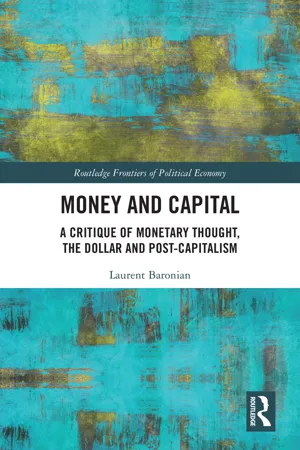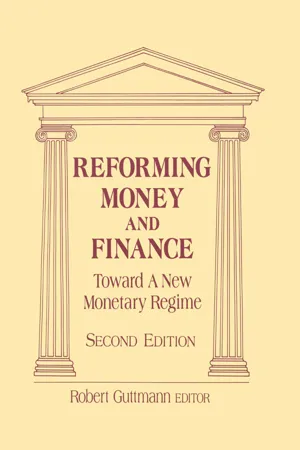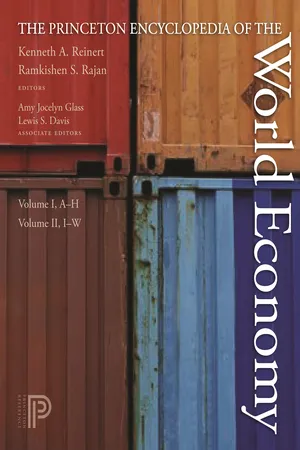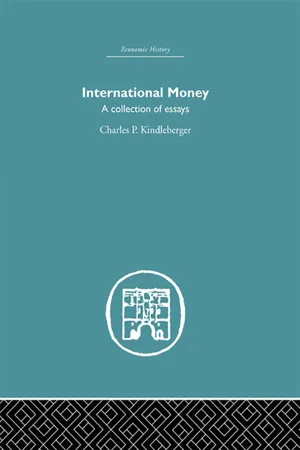Economics
Eurodollar
Eurodollars are U.S. dollar-denominated deposits held in foreign banks, primarily in Europe. They are not subject to U.S. banking regulations and are often used for international transactions and as a source of short-term funding for banks and corporations. The Eurodollar market is an important component of the global financial system, providing liquidity and flexibility for participants.
Written by Perlego with AI-assistance
Related key terms
Related key terms
1 of 4
Related key terms
1 of 3
7 Key excerpts on "Eurodollar"
- eBook - ePub
Money and Capital
A Critique of Monetary Thought, the Dollar and Post-Capitalism
- Laurent Baronian(Author)
- 2022(Publication Date)
- Routledge(Publisher)
Burn, 2006 : 4).Eurodollars are, literally, nothing more than dollar-denominated time deposits that are not subject to the US banking regulation because they are issued by a non-US commercial bank or a non-US branch of a commercial bank. The expansion of these deposits occurs when a Eurobank re-deposits Eurodollar funds that have been deposited with it. Each re-deposit creates a deposit liability on the Eurobank’s balance sheet; the total Eurodollars created can therefore be several times the original claim on the Eurobank (Greenberg, 1983 : 1495). These are time deposits (or certificates of deposit, see below) which cannot be used as a means of exchange to settle debts. On the one hand, and unlike bank deposits, there is no ex nihilo issuance of dollars on this market since here credit in Eurodollars is conditional on an initial deposit in a New York bank. Moreover, it is not possible to draw cheques on these deposits, for example, and thus to bring these deposits into commercial circulation other than by converting them into cash. But on the other hand, these deposits, whose maturity varies between one day and five years but mostly between one week and six months (Murau, 2018 : 18), are permanently replicated: “Once money is raised, then without a reserve requirement it can be loaned, deposited, re-loaned, re-deposited, re-loaned, and so on in offshore markets without limits imposed by the banking system” (Allen, 2016 : 4). This is what inspired Friedman to say that Eurodollars only come from the bookkeeper’s pen.6 - eBook - ePub
Debt, Crisis and Recovery: The 1930's and the 1990's
The 1930's and the 1990's
- Albert G. Hart, Perry G. Mehrling(Authors)
- 2016(Publication Date)
- Routledge(Publisher)
Important banks in all countries have for decades run branches in foreign financial centers. These have been useful in the financing of international trade, helpful to businessmen and tourists abroad, and presumably helpful in legitimate coordination of activities with foreign commercial banks (for example, arranging for syndication of loans). Much more recent (dating only from the 1960s) is the mushrooming of overseas-bank activity as a fundamental part of the growth of exocurrencies, of which the Eurodollar is the leading example. A great stimulus to this development was given when the United States Government (in the early years of its worries about what now look like trifling payments deficits) required overseas financing for overseas investment by U.S.-based industrial companies. It proved that it was perfectly feasible to find customers who would hold funds in overseas branches rather than in mainland-U.S. bank offices (particularly since the bank could offer interest payments without running afoul of the U.S. law against interest on demand balances), and that loans denominated in dollars but contracted with overseas branches could thus be financed.A crucial aspect of Eurodollar banking proved to be that by shifting activities to this form, a bank—and not only a U.S. bank but a British or continental bank—could climb outside the regulatory jurisdiction of its own central bank without subjecting itself to any other central bank.Where choice exists between booking a loan at a New York head office or from a Nassau branch, the bank need not concern itself with such restrictions as the fraction of its total capital that may be represented by lands to a single borrower, can keep its relations with the customer more confidential, and can offer interest rates that are shaded somewhat because the bank can use funds not subject to U.S. reserve requirements. And in buying money to finance its lending, the bank can offer somewhat more favorable interest and subject the creditor to fewer inconveniences if customers will hold funds in CDs or deposits (ordinarily time deposits, though they may be of very short maturity) purporting to be in Nassau.An awkward side of the Eurobanking situation is that since the first OPEC oil crisis of 1973-74, the Eurobankers have to a considerable degree placed the governments of the United States and other industrial countries under obligation by what is called "recycling of petrodollars." Eurodollar loans eased a potential payments crisis arising from the payments deficits of oil buyers—doing something which governments much wanted done, but for which they had no machinery in place and could not quickly improvise machinery. Thus while Eurobanking remains one of the most private operations in the industrial world in terms of regulation and reporting of information, it has become affected with a public interest in a way that may create moral obstacles to needed reform measures. - eBook - ePub
Reforming Money and Finance
Institutions and Markets in Flux
- Robert Guttmann(Author)
- 2016(Publication Date)
- Routledge(Publisher)
Eurodollar system and comes under no national regulatory authority. The system takes its name from, and is defined by, the phenomenon of currencies used outside the borders of any country. It is, therefore, outside the jurisdiction of its nation of origin.The birth of this system goes back to the late 1940s, when the Soviet Union placed its dollar holdings in a French bank to avoid the possibility of having these accounts frozen, should the United States employ this strategy to wage the cold war. The funds grew slowly, and their potential was not realized until the United States imposed capital export controls in the 1960s. Banks and their multinational corporate customers then found ways around the exchange controls by using the Eurodollar system. The system reached maturity in the 1970s by being the principal receptacle of some $350 billion in surpluses earned by OPEC countries.About 85 percent of this surplus is made up of dollars, with German marks and Japanese yen being the two other principal currencies. Technically, these currencies should be regulated in the jurisdiction in which they are used—a practice ignored for fear that the operations would be moved to an unregulated venue, if a government began to regulate their activities. We do not even have a good accounting of the dollars in the Eurodollar markets. A rough estimate is that it is nearly $2 trillion. But no agency of the United States government regulates or monitors its movements.Central Banking Reform
Effectively, the Federal Reserve Board has abdicated its central function of control over the portion of the money supply that is influenced by the Eurodollar system. The principal control instrument is the power to set reserve requirements. These are set-asides against deposits that banks are required to sequester. For the dollars that circulate inside the United States, banks are required to set aside such reserves. This is what limits the expansion of the money supply, affords the Federal Reserve control over this crucial monetary function, and allows it to influence interest rates. But no such reserve controls exist for Eurodollars. The growth of this component of the money supply lies solely in private bank hands. Here, banks can theoretically lend out all their deposits, even though they tend to hold small reserves—less, however, than is required on domestic accounts. The ability to hold less idle reserves is what makes the Eurodollar system so attractive to banks. They can make all their deposits work for them, thereby receiving larger profits. Because of these profits, they can charge lower interest rates than on domestic borrowing. The policy of extending reserve requirements to Eurodollars, therefore, would place them on an equal footing with domestic dollars. It would eliminate what is now an incentive for banks to hold and invest dollars outside the United States where they can earn higher profits, charge lower rates of interest, and escape regulatory and tax obligations. - Kenneth A. Reinert, Ramkishen Rajan, Amy Joycelyn Glass, Lewis S. Davis, Kenneth A. Reinert, Ramkishen Rajan, Amy Joycelyn Glass, Lewis S. Davis, Kenneth Reinert, Ramkishen Rajan, Amy Glass, Lewis Davis(Authors)
- 2010(Publication Date)
- Princeton University Press(Publisher)
Causes of Growth The long-term growth of the Eurocurrency market was driven neither by politics nor by regulatory worries, but instead by economics. From the beginning, the British authorities set a precedent by not attempting to regulate Eurocurrency banking. To this day, in all of the world’s major financial centers, neither home- nor host-country regulators impose any of the costly burdens that they place on domestic banks: requirements such as holding noninterest-bearing reserves, interest rate controls, deposit insurance, or high taxes. Typically also, restrictions on the entry of new banks are minimal. Moreover, “Eurobanks”—that is, the international departments of big banks that offer offshore deposits—accept only wholesale deposits, mostly $1 million or more. As a result of all these regulatory and economic advantages, Eurobanks are able to offer interest rates on deposits that are higher than in the currency’s home country, and also interest rates on loans that are lower. In short, the “spreads” between loan and deposit rates are lower on Eurobanks’ offshore deposits than at home.A major impetus for growth of Eurobanking came with the virtual doubling of oil prices in the fall of 1973. In the context of heightened tension with the United States over its support for Israel, Middle Eastern oil exporters deposited much of their expanding oil revenues in Eurodollars in London. At the same time, oil-importing countries were hungry for hard currency loans. The Eurocurrency market expanded rapidly to meet this demand. Doomsayers had predicted disaster if the oil revenues were not “recycled.” The International Monetary Fund (IMF) had until then been the conventional lender to deficit countries but lacked capacity to recycle such unprecedented amounts. The Eurocurrency markets grew seamlessly and saved the day.By the late 1970s, the value of Eurodollar deposits exceeded the value of dollar deposits within the U.S. banking system. In December 1981, U.S. banking legislation was revised to allow U.S. banks to offer “international banking facilities” (IBFs)—that is, dollar deposits and loans to nonresidents of the United States and to other IBFs that are immune from U.S. regulatory requirements. Hence U.S. banks could offer deposit and loan rates competitive with the larger Eurodollar markets in London and elsewhere. More than 75 percent of U.S. IBF banking is in New York, with almost all the rest in California and Illinois.- eBook - ePub
The Political Economy of U.S. Monetary Policy
How the Federal Reserve Gained Control and Uses It
- Edwin Dickens(Author)
- 2016(Publication Date)
- Routledge(Publisher)
banks did not concede defeat and give up their international financial business. Instead, they started bidding for dollar deposits to lend to their clients in the former colonies. Even though there is no data available prior to 1964, the data presented in Table 6.1 suggest that between 48.6 percent and 68.6 percent of the net size of the Eurodollar market can be accounted for by U.K. banks replacing an international financial business based on sterling with one based on dollars. 3 Two factors explain the ability of U.K. banks to substitute dollars for sterling in their international financial operations. First, with cumulative U.S. balance-of-payments deficits of $33.8 billion by the end of 1965, there were plenty of dollars sloshing around for U.K. banks to bid for. Second, with a bank cartel in the U.S. maintaining a monopoly price for dollar loans in the early 1960s, there was ample opportunity for U.K. banks to build a profitable dollar-based business and still entice clients with loans priced below the monopoly price. To speak more precisely, the monopoly price for dollar loans in the early 1960s was a 4.5 percent lending rate (i.e. the U. S. prime rate) plus a requirement that borrowers maintain compensating balances of 10 percent to 20 percent of loans. The cost of borrowing dollars from the U. S. bank cartel thus ranged from 0.045/1 − 0.1 to 0.045/1 − 0.2, or from 5 percent and 5.6 percent. During the same period, the interest rate on Eurodollar deposits averaged 4.1 percent. Therefore, U.K. banks had ample room to bid for Eurodollar deposits then lend them at profitable margins while still underpricing loans offered by the U.S. bank cartel. As a reflection of this fact, by the end of 1965 U.K. banks had attracted $5.3 billion of Eurodollar deposits, an amount equal to 15.7 percent of the $33.8 billion sloshing around in the world economy as a result of U. S. balance-of-payments deficits. 4 Table 6.1 Net size of the Eurodollar market and the U.K - eBook - ePub
International Money
A Collection of Essays
- Charles P. Kindlerberger(Author)
- 2013(Publication Date)
- Routledge(Publisher)
The sharp contraction of the Eurobond market was accompanied by sizeable expansion in Eurocurrency long-term loans with interest rates adjusted each six months to the London Inter Bank Offer Rate (LIBOR) – another classic example of quantity coming to dominate price. Governmental and parastatal units in especially France, Britain and Italy borrowed billions of dollars in this way from Eurocurrency banks at rates up to fifteen years until in the Summer of 1974, following the failures of the Franklin National and Herstatt Banks from speculation in foreign exchange, the Eurocurrency banks began to hold back from such loans. Eurobanks started off blithely enough, lending long for fifteen years against liabilities of typically five days, in the belief that any withdrawal of dollars by depositors would be controlled by recycling. In the Summer of 1974, concern was less for the nervousness of depositors than for the credit worthiness of borrowers. Eurodollar depositors were locked in so long as any central bank which purchased the dollars to make its local currency available to parties withdrawing from the Eurodollar market would in turn redeposit the dollars in Eurocurrency centers. Fear of default by some large borrower, which was first felt in the Summer of 1974, created a new and much more dangerous risk.Outside the Eurocurrency market, floating does not appear to have discouraged international investment. Portfolio movements both in and out of the USA rose prior to the decline in stock-exchange averages in the Summer of 1974. United States direct investment outward declined slightly in 1972 from the high level of 1971 and much more sharply in 1973, to levels of 1967, which were, however, still substantial. Foreign investment in the USA, on the other hand, rose considerably, suggesting the possibility, currently under investigation, that direct investment is responsive to over- and undervaluation of exchange rates.In short-term markets, however, capital movements neither dried up nor turned tamely stabilizing. Leads and lags operated against the dollar as multinational corporations, many of which protested that they never sold dollars, at least postponed buying them with foreign profits. Inside the USA the demand for loans was substantial and some considerable part of it appears to have been for selling dollars short. How much of the short-term capital outflow in 1972 and 1973 was speculative, leaning on the dollar to drive it still further down, and how much was a continued response to differential interest rates lower in the USA than in Europe cannot readily be determined. Exchange speculation seems, however, to have spread widely.The initial view of the banks was that they enjoyed flexible exchange rates. They widened margins, and increased turnover. Walter Wriston’s statement, noted above, that the system was good for banks, and that if industrial companies regarded it as a headache, it was the number three headache, not the number one, was made before the failure from excessive speculation of the Franklin National Bank and the Herstatt. Banks have learned that their foreign-exchange departments can run exchange risks during the day, within which foreign currencies may fluctuate by as much as 3 or 4 per cent, even when they close out net positions at the end of the day. And all banks have become more alert to the credit worthiness of the names whose paper they buy. In the early stages, foreign-exchange departments spent time calculating spreads and gave little thought to credit worthiness, an issue handled in another department of the bank. The troubles of the Spring of 1974 changed this. - eBook - ePub
Dilemmas of the Dollar
Economics and Politics of United States International Monetary Policy
- C. Fred Bergsten(Author)
- 2017(Publication Date)
- Routledge(Publisher)
The key currency roles of the dollar—including the restrictions on U.S. capital exports to defend those roles—un-doubtedly contributed to the inducement to U.S. banks to invest abroad, to maximize the potential earnings available to them through financing third-country trade and Eurodollar transactions. The roles must therefore be charged with perhaps one-half the short-term balance-of-payments costs of the net annual outflow, perhaps $150 million in 1972. 36 Finally, it will be recalled that a key currency country can most directly maintain foreign confidence in its fixed-price convertibility by extending exchange-value guarantees on foreign holdings of its currency. The dollar's roles thus levy on the United States the contingent costs of restoring the value of foreign holdings in the event of a dollar devaluation to the extent that it guarantees the value of such holdings in terms of SDRs, gold, or another currency, 37 The United States has heretofore extended such guarantees only on swap drawings and Roosa bonds. As a result of the 1971 devaluation, it incurred a liability estimated at $172 million on these debts—implying that about $2 billion, or 3 per cent of foreign dollar holdings (4 per cent of official holdings) carried guarantees. 38 Conclusion The several direct economic effects of the international roles of the dollar on the U.S. balance of payments are summarized in the following tabulation. For purposes of demonstrating the evolution over time, it compares the effects which policy-makers could anticipate in 1973 with those which could have been anticipated at the end of i960 and at the end of 1968. The three-month Treasury bill rate in each year 38 is used to estimate interest payments, and it is assumed that lending rates by U.S. banks in each case averaged one percentage point higher. Several conclusions derive from this analysis
Index pages curate the most relevant extracts from our library of academic textbooks. They’ve been created using an in-house natural language model (NLM), each adding context and meaning to key research topics.
Explore more topic indexes
Explore more topic indexes
1 of 6
Explore more topic indexes
1 of 4






